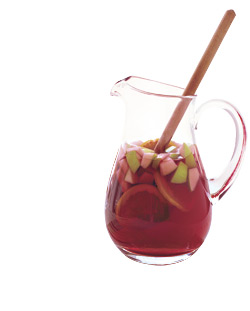In Spain, sangria is a drink completely tied to set and setting—usually a big backyard party. Young Spanish punks may guzzle red wine and Coca-Cola in the bars like it’s the coolest thing in the world, but their elders wouldn’t be caught sipping sangria in public. The Spanish look down on the tourist habit of purchasing sangria by the pitcher because, well, when did you last go to a bar and order a bowl of punch to split with friends? Sangria is a social beverage, a thrifty way to turn one bottle of wine into three with a little magic, a dash of sugar, and some fruit. It’s also a great drink to guzzle with spicy summer food, whether it’s takeout tacos or backyard barbecue.
The ingredients for sangria are limited only by your imagination. The basic recipe includes one bottle of cheap red, one cup of brandy, sliced fresh fruit (approximately one lemon and one orange), and two to four cups of lemonade and lemon-lime soda—use more soda for a fizzier sangria, more lemonade for a tarter one. To make your sangria stronger in alcohol, use lemon, orange, or lime juice and sugar in lieu of this blend. Oranges, lemons, and limes are my top choice for sliced fruit to float on top, but peaches and nectarines are delicious when in season. Let everything but the wine sit together in a pitcher overnight. Add the wine and ice right before service. You add the red wine last for the same reason an open bottle of cheap red tastes gross the next day.
The little sour note of cheap red wine mixes with the sweet from the juice and sugar and brings out a pleasant fruitiness. You can make your sangria as light or as strong as you like, but make sure everything you add adds flavor—for example, choose brandy and lemonade instead of vodka and club soda. If you water sangria down, you lose that fruity acidity needed to zest up the red wine.
In a pinch, sangria can be made by the glass, as a visit to Sun Liquors and a drop of their on-the-fly version taught me. Just pour a cup’s worth of red wine over ice and start adding the other ingredients by the splash until you find it palatable. This is the way I make sangria these days—when I have one glass of wine left in a bottle but I want something refreshing. Whatever you do, don’t buy premade sangria. These bottlings usually have a pretty awful flavor, but that could be a psychological reaction to their lack of freshness.
Let’s face it: Sangria won’t win any beauty contests, but it’s not about glamour. It’s a satisfying, grown-up punch that you can drink with food or by itself. When I see sangria at a party, I consider it a good sign of a laid-back host.
Senor Moose pours my favorite sangria in town right now. I do shake a finger at the restaurant’s $7.50 price tag, for the same reason Spaniards probably shake their heads at vacationing Brits paying top euro for what amounts to bathtub punch. Sangria may be the ultimate in cheap, irreverent beverages, and you shouldn’t have to pay a premium for it.





